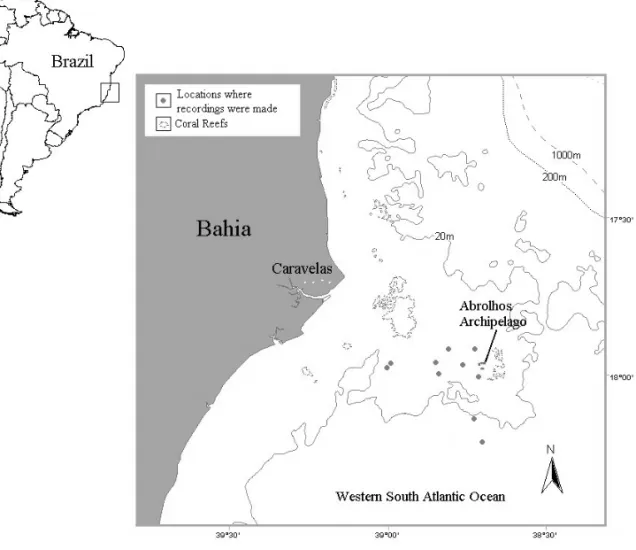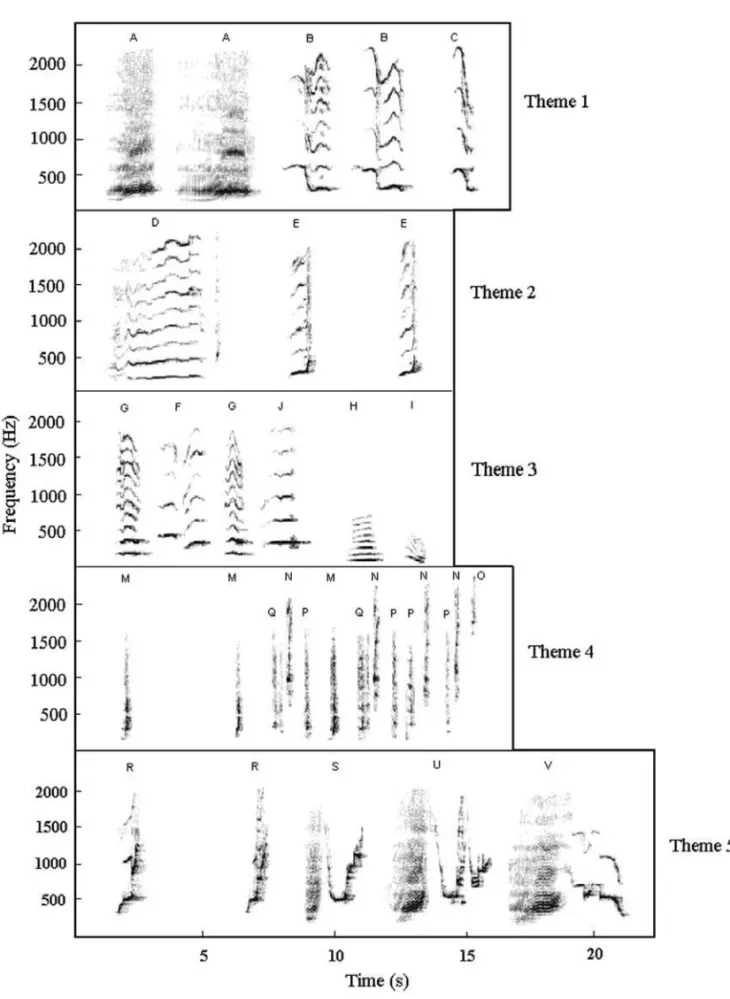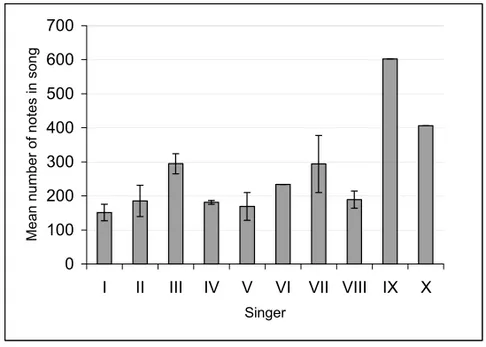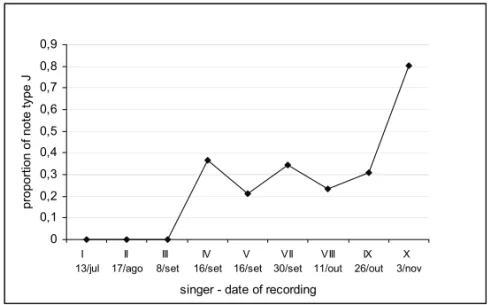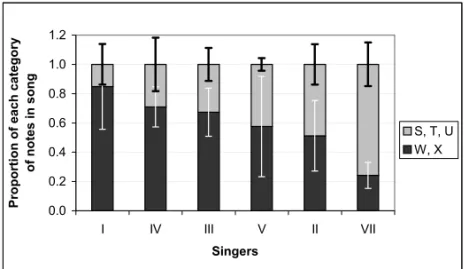www.scielo.br/aabc
The song of the Brazilian population of Humpback Whale
Megaptera novaeangliae
, in the year 2000: individual song
variations and possible implications
EDUARDO M. ARRAUT and JACQUES M.E. VIELLIARD*
Laboratório de Bioacústica, Instituto de Biologia, Universidade Estadual de Campinas Cx. Postal 6109, 13083-970 Campinas, SP, Brasil
Manuscript received on January 15, 2004; accepted for publication on February 5, 2004.
ABSTRACT
The song of the Brazilian population of the Humpback WhaleMegaptera novaeangliaewas studied in its breeding and calving ground, the Abrolhos Bank, Bahia, Brazil, from July to November 2000. Aural and spectral analyses of digital recordings were completed for approximately 20 song cycles, totaling 5 hours of song from 10 different recording events. We identified 24 note types, organized in five themes. All songs presented the same themes and the order in which they were sung did not vary. We registered the appearance of a note type and the disappearance of a phrase ending, which indicate that the song changed as the season progressed. Moreover, we detected individual variation in the way singers performed certain complex note types. As songs are transmitted culturally, it is likely that singers have different abilities to compose and/or learn new notes. If, as it has been previously suggested, ‘new’ songs are preferred to ‘old’ ones, these more able singers will be sending out information about their learning abilities that could be used by other whales to decide whether or not to interact with them.
Key words:Humpback Whale,Megaptera novaeangliae, song, Brazilian population, 2000, individual song variation.
INTRODUCTION
The Humpback Whale Megaptera novaeangliae
sings long and complex songs (Payne and McVay 1971) that change, at a non-uniform rate, with time (Payne et al. 1983, Cato 1991). To date, singers have been found to be males (Darling and Berube 2001), which sing predominantly on their breeding and calving grounds (Payne and McVay 1971). One song cycle typically lasts from 6 to 35 minutes and singers usually repeat various cycles continuously to the point that a song session has been observed to last 22 hours (Winn and Winn 1978). The function
*Member of Academia Brasileira de Ciências Correspondence to: Jacques M.E. Vielliard E-mail: jacques@unicamp.br
of the song seems to be related to mating behav-ior – possibly to attract females (Winn and Winn 1978, Tyack 1981, Clapham 1996) and to signal sta-tus to other males (Darling and Berube 2001). The vocal repertoire of the species also includes calls, ei-ther by competitive groups formed in winter breed-ing grounds (Tyack 1983, Silber 1986, pers. obs.) or by whales involved in group feeding in summer grounds (Mattila et al. 1987).
There are Humpback Whale populations in all oceans of the world, each one possessing its own characteristic song. In contrast, individuals of the same population generally sing a similar song (Winn and Winn 1978).
hemi-374 EDUARDO M. ARRAUT and JACQUES M.E. VIELLIARD
sphere, such as that of Payne and Payne (1985), have established certain patterns in the song structure that also seem to be true for the Australian populations (Cato 1991). The results of the study reported here show that the song of the Brazilian population in the year 2000 conforms to these same patterns. More-over, we detected individual variations in the song, for which we suggest possible implications.
MATERIALS AND METHODS
This study was carried out at the Abrolhos Bank (17◦S and 38◦W), an enlargement of the Brazilian continental shelf situated on the southern part of the State of Bahia, Northeastern Brazil (Fig. 1), the only known winter breeding and calving ground of the Humpback Whale in the Western South Atlantic Ocean.
Songs were recorded using Sony TCD D-10 and D-8 digital tape-recorders, and a home-mounted omni-directional hydrophone. Subsequent record-ings were generally temporally segregated by more than one day, sometimes a week, and recording sites were randomly (although not intentionally so) spaced across the Abrolhos Bank.
Aural and spectral analyses were carried out for 10 different recording sessions (apparently 10 different singers), adding to a total of 5 hours of songs and 20 song cycles. The Spectrogram (version 5.1.7) software was used for a real-time check of the recordings and Cool Edit Pro to produce sonograms and to measure note parameters, namely: duration of the note, duration of the interval in between sub-sequent notes, minimum and maximum frequencies. A total of 4474 notes were measured.
For the analysis regarding the individual varia-tion, we divided the note types that occupy the sec-ond part of the phrases of theme 5 into two cate-gories: note types W and X form the first and S, T and U the second, more elaborate ones. We then counted the total number of notes belonging to each of the two categories per song session and calculated the average number of elaborate and non-elaborate notes in each singer’s song cycle.
RESULTS AND DISCUSSION
The song of the Brazilian population of Humpback Whale in the year 2000 is composed of 24 note types, organized in 5 themes (Fig. 2). This reper-toire is somewhat larger than the 12 to 15 note types that Cato (1991) considered to be typical for the song of the East Australian population, and there are three possible explanations: we have established narrower limits for the note character variation, the greater number of note types is characteristic of the Brazilian population or 2000 was not a typical year. All songs are constituted of the same five themes. No theme was left out of any song cycle and there was no variation in the order that themes were sung. This uniformity corroborates current knowl-edge that individuals within a population sing a sim-ilar song (Cato 1991).
When we compared songs of different individ-uals or different songs in the same song session, we observed that the quantity of notes per song cycle varied considerably both between individuals and between successive song cycles (Fig. 3). This vari-ation is the result of the different number of phrases repeated in each theme. Payne and Payne (1985), studying the alterations of the song throughout 19 years, concluded that songs in a population are sim-ilar with regard to phrase and theme structure, as well as in their sequences, although the number of phrases in any particular theme is unpredictable ei-ther within a song session or between them. The same observations have been made in the present study.
We also observed that some note types seem to emerge from the modification of others. This progressive change of the characteristics of a certain note type into a new one has been observed by Winn and Winn (1978) and Cato (1991).
stand-Fig. 1 – Study region on the Western South Atlantic Ocean indicating the Abrolhos Archipelago and the locations where recordings were made.
ing with the ‘tail up’ or in slow, non-directional swimming. These singers are generally lone whales spaced a few kilometers apart. As in breeding areas there seems to be no food, females tend to be very mobile, avoid each other mutually and distribute themselves irregularly in space (Clapham 1996). All these spatial and behavioral traits are typical of a lek, and Clapham (1996) suggested the term ‘float-ing lek’ for the Humpback Whale’s mat‘float-ing system, stressing the singer mobility displayed by the species, in contrast to traditional, spatially fixed leks.
Song Alterations Related to the Progression of the Breeding Season
Two inter-individual variations seem to be related to the progression of the breeding season. The first
376 EDUARDO M. ARRAUT and JACQUES M.E. VIELLIARD
0 100 200 300 400 500 600 700
I II III IV V VI VII VIII IX X
Singer
Mean number of notes in song
Fig. 3 – Mean number of notes per song cycle of each singer. Bars with no SD indicate that only one song cycle was analyzed.
0 0,1 0,2 0,3 0,4 0,5 0,6 0,7 0,8 0,9 1
I 13/jul
II 17/ago
III 8/set
IV 16/set
V 16/set
VII 30/set
VIII 11/out
IX 26/out
X 3/nov
singer - date of recording
proportion of HM
Fig. 4 – Proportion of phrases ending in HM in each singer’s song session. This proportion is the number of phrases ending in HM divided by the total number of phrases present in the theme (phrases ending in HH + HI + II + HM). Singers (I to X, less singer VI for which the recording was too short for calculation) are presented in chronological order.
1983). Among the several forms of song alteration observed by Payne et al. (1983), one of them was the replacement of a certain note type by another. In our study, the appearance of note type J seems to have been through the modification of another note type F, though the latter did not disappear.
378 EDUARDO M. ARRAUT and JACQUES M.E. VIELLIARD 0 0,1 0,2 0,3 0,4 0,5 0,6 0,7 0,8 0,9 I 13/jul II 17/ago III 8/set IV 16/set V 16/set VII 30/set VIII 11/out IX 26/out X 3/nov
singer - date of recording
proportion of note type J
Fig. 5 – Proportion of phrases containing note type J, calculated as the number of notes J divided by the sum of notes F, L and J (these three note types occupy the same relative position in the phrases of theme 3: third and/or fifth notes of every phrase). Singers as on figure 4.
Possible Individual Variation in Song Learning
We detected individual variation in the way singers performed certain complex note types. In theme 5, the note types following notes R are of two structural categories, a relatively simple (note types X and W) and a more complex one (note types S, T and U), as illustrated in part on figure 6. The proportion of notes of these two categories varies from one singer to another. In figure 7, the six singers for which we have enough recording are ordered according to the decreasing proportion of simpler notes uttered. This order, to the contrary of the changes related before, does not represent the progression of the breeding season. Thus, if we admit that the song is transmit-ted through learning (Payne et al. 1983, Noad et al. 2000), these individual differences suggest that singers have different abilities to compose and/or to learn their song. If this is true, singers that com-pose and singers that learn the changes faster and better sing a novel song earlier on in the breeding season. Furthermore, if, as suggested by Noad et al. 2000, novelty drives song change – which im-plies that novel songs are more attractive to other whales than ‘old’ ones – individuals that compose
and/or learn faster send out information about their differential learning abilities that could be used by other whales to decide whether or not interact with them. Therefore, sexual selection in the Humpback Whale would be made through the ability to acquire quickly and perform properly new sound structures in the song.
As our data are too limited for further develop-ment of such assumptions, we can only stress here the necessity to gather enough recordings to doc-ument better and through a longer time the intra-and inter-individual variations in the song. It would also be necessary, in order to test our hypothesis on the species mating system, to identify the sex of the singers, monitor the interactions of these known singers with other whales of known sex, and deter-mine the reproductive success of each one of the singers by genetic analyses.
CONCLUSION
Fig. 6 – Sonograms of phrases containing note types of the two categories that we established for theme 5: simpler on upper row (singer I), more complex on lower row (singer VII). Scales as in figure 2.
0.0 0.2 0.4 0.6 0.8 1.0 1.2
I IV III V II VII
Singers
Proportion of each category
of notes in song
S, T, U W, X
Fig. 7 – Proportion of each of the two categories of note types in theme 5 (see figure 6). The proportions shown are the average (with standard deviation) for all song cycles of each singer.
learn the changes, as this would probably improve our understanding of the song’s behavioral function.
ACKNOWLEDGMENTS
Financial and logistical support was received from ‘Instituto Baleia Jubarte’, the Conselho Nacional de Desenvolvimento Científico e Tecnológico (CNPq),
380 EDUARDO M. ARRAUT and JACQUES M.E. VIELLIARD
RESUMO
Estudamos o canto da população brasileira de Baleia-jubarteMegaptera novaeangliaeem sua área de repro-dução – a região do Banco dos Abrolhos, Bahia – de julho
a novembro do ano 2000. Completamos análises audi-tiva e espectral de aproximadamente 20 ciclos de canto,
em um total de 5 horas de gravações provenientes de 10
ocasiões diferentes. Identificamos 24 tipos de notas, or-ganizadas em cinco temas. Todos os cantos são formados
pelos mesmos temas e não houve variação na ordem na qual foram cantados. Registramos o aparecimento de um
tipo de nota e o desaparecimento de uma terminação de
frase, o que indica que o canto mudou ao longo da tem-porada de reprodução. Mais ainda, detectamos variação
individual na forma como os cantores emitiam certos tipos
de notas mais complexos. Uma vez que o canto é transmi-tido culturalmente, é provável que os cantores tenham
ha-bilidades diferentes para compor e aprender novas notas. Se, como já foi sugerido anteriormente, cantos ‘novos’
são preferidos a cantos ‘antigos’, cantores mais capazes
estariam mandando informação sobre suas habilidades de compor e aprender que pode ser usada por outros
indiví-duos para decidir quanto a interagir ou não com eles.
Palavras-chave: Baleia-jubarte, Megaptera novaean-gliae, canto, população brasileira, ano 2000, variação individual no canto.
REFERENCES
Cato DH.1991. Songs of Humpback Whales: the
Aus-tralian perspective. Mem Queensl Mus 277-290.
Cerchio SJ, Jacobsen K and Norris TF.2001. Tem-poral and geographical variation in songs of Humpback Whales,Megaptera novaeangliae: syn-chronous change in Hawaiian and Mexican breeding assemblages. Anim Behav 62: 313-329.
Clapham PJ.1996. The social and reproductive
biol-ogy of Humpback Whales: an ecological perspective. Mammal Review 26: 27-49.
Darling JD and Berube M. 2001. Interactions of singing Humpback Whales with other males ( Mega-ptera novaeangliae). Mar Mammal Sci 17: 570-584. Dawbin WH and Eyre EJ.1991. Humpback Whale
songs along the coast of Western Australia and some comparison with East Coast songs. Mem Queensl Mus 249-254.
Guinee LN and Payne KB.1988. Rhyme-like repeti-tions in songs of Humpback Whales. Ethology 79: 295-306.
Mattila DK, Guinee LN and Mayo CA.1987.
Hump-back Whale songs on a North Atlantic feeding ground. J Mammal 68: 880-883.
Noad MJ, Cato DH, Bryden MM, Jenner MN and Jenner CS.2000. Cultural revolution in whale
songs. Nature 408: 537.
Payne KB and Payne RS.1985. Large scale changes
over 19 years in songs of Humpback Whales in Ber-muda. Z Tierpsychol 68: 89-114.
Payne KB, Tyack P and Payne RS.1983. Progressive changes in the songs of Humpback Whales ( Mega-ptera novaeangliae): a detailed analysis of two sea-sons in Hawaii. In:Payne RS(Ed), Communication and behavior of whales. Boulder, Colorado: West-view Press, p. 9-57.
Payne RS and McVay S.1971. Songs of Humpback Whales. Science 173: 585-597.
Tyack P.1981. Interactions between singing Hawaiian
Humpback Whales and conspecifics nearby. Behav Ecol Sociobiol 8: 105-116.
Tyack P. 1983. Differential response of Humpback
Whales, Megaptera novaeangliae, to playback of songs or social sounds. Behav Ecol Sociobiol 13: 49-55.
Winn HE and Winn LK.1978. The song of the
